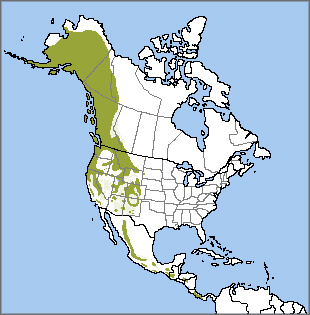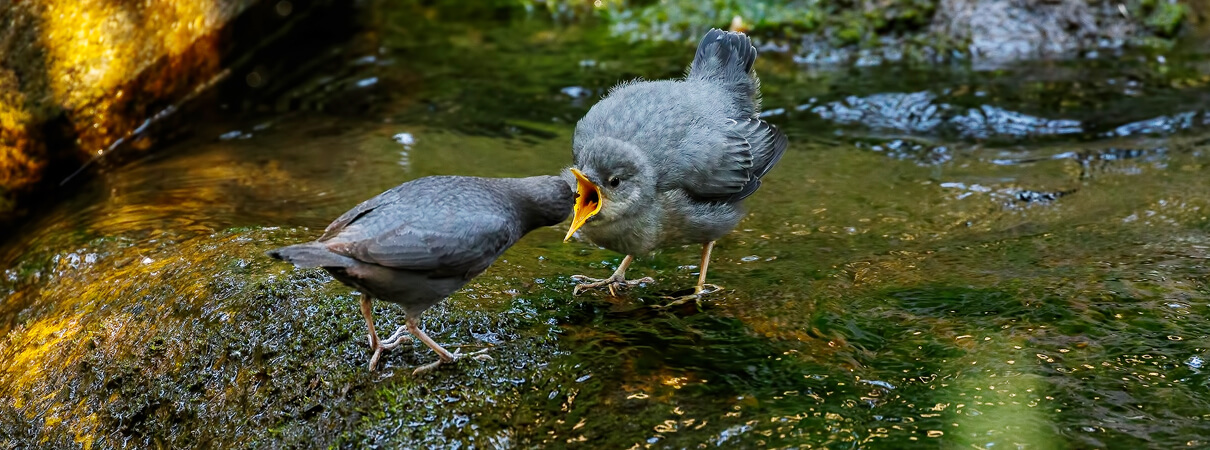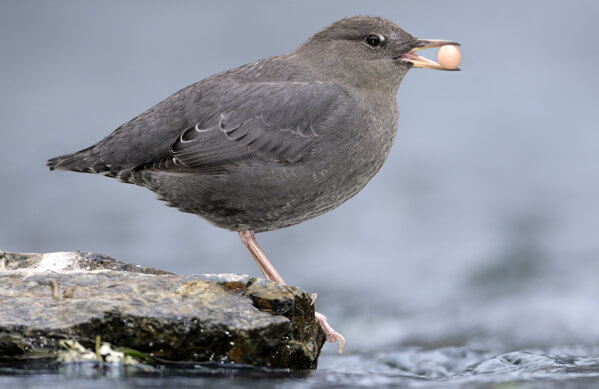
The plump, long-legged American Dipper is colored like a Gray Catbird, about the size of a Cactus Wren, and cocks its short tail like a Common Yellowthroat. But the American Dipper is unique — it's the only North American songbird that routinely swims!
Named for its constant up-and-down bobbing movements, this unusual bird has a number of adaptations that allow it to live an aquatic lifestyle.
Swimming Songbird
Since the American Dipper spends a lot of time in and around cold water, it has a number of special adaptations that allows it to survive in that environment. This swimming songbird has a lower-than-usual metabolic rate and extra oxygen-carrying capacity in its blood — both important for retaining body heat in cold water.
The uropygial, or preen, gland at the base of a dipper's tail (a feature shared by most birds, but best-developed in aquatic species including the Black-capped Petrel and Brown Pelican) produces extra oil, important for helping keep plumage waterproof. Extra eyelids, known as nictitating membranes, protect its eyes underwater as it forages for food, and a flap of skin covering the nostrils keeps water out when it dives.
A Ladle of Dippers
American Dippers (known collectively as a ladle) have five recognized subspecies, separated by subtle color differences. Most are permanent residents in suitable habitat throughout their range, which stretches from northern Alaska south throughout the Rocky Mountains, Cascades, and Sierra Nevada, as far south as western Panama. If necessary, dippers will make short-distance movements south or to lower elevations to find food or unfrozen water.
The dipper's song, sometimes hard to hear over fast-rushing water, is a series of repeated high whistles or trills. Both sexes sing year-round.
(Audio of American Dipper by Ted Floyd XC460525, accessible at www.xeno-canto.org/460525)
Feeding On (and Under) Water
This indomitable bird wades, swims, and even dives into ice-cold mountain streams in pursuit of prey, which consists of aquatic insects and their larvae, small fish and fish eggs, crayfish, and tadpoles. It catches most of its food underwater, using stubby wings to "swim," but can also be observed wading with head submerged as it forages, even turning over rocks to find prey hiding underneath. The dipper also snags prey from the water's surface while swimming. American Dippers have been recorded feeding in salmon spawning areas.
The American Dipper's "dipping" motion, and the flash of its white-feathered eyelids as it blinks, serve as important visual cues to other dippers — vitally important in an environment dominated by the sound of rushing water.

American Dipper feeding its young. Photo by Bryan St.Croix/Shutterstock
Waterside Nesting
A male American Dipper defends a linear territory stretching along the banks of a river, stream, or lake. Dippers are usually monogamous, and frequently pair up with the same mate from year to year. Polygamy is sometimes observed, when a male attracts two females to nest in his territory. In that case, the females stagger their clutches, and the male helps care for both sets of young.
The female dipper builds a dome-shaped nest with a side entrance, located close to water on a rocky ledge or riverbank, or beneath a bridge. Since these riparian nest sites are damp and cold, the nest has multiple layers of moss, grass, leaves, and bark to ensure that the eggs stay warm. This insulated nest can sometimes be larger than a soccer ball, and may be reused from year to year.
An especially enterprising female dipper may even build her nest behind a waterfall for an extra layer of protection — and she and her mate, undeterred by the falling water, will simply fly through it to reach their nest site.
Found Where Clean Water Flows
Clean water is essential for healthy American Dipper populations. Unfortunately, this unique aquatic bird has disappeared from some areas due to habitat loss and water pollution caused by poor practices in clearcutting, mining, and agriculture. Runoff and siltation from careless land management practices raise stream temperatures and destroy the aquatic food sources upon which dippers depend. Riverbank erosion also destroys dipper nesting habitat.
ABC's Policy team continues to advocate for public land protections, including the Northwest Forest Plan, which will protect forests and waterways essential to the American Dipper as well as species ranging from the Varied Thrush to Spotted Owl.
We also continue to monitor proposed changes meant to weaken the Migratory Bird Treaty Act, an essential law that's key to continued bird protection in the United States. We will continue fighting to keep it intact, protecting unique species such as the American Dipper.
Donate to support ABC's conservation mission!



















































